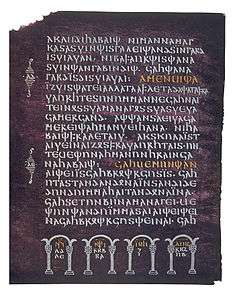Gothic Bible

| Part of a series on the |
| Bible |
|---|
 |
|
Perspectives |
|
Outline of Bible-related topics |
The Gothic Bible or Wulfila Bible is the Christian Bible as allegedly translated by the Arian bishop and missionary Wulfila in the fourth century into the Gothic language spoken by the Eastern Germanic (Gothic) tribes.[1] Recent scholarly opinion, based on analyzing the linguistic properties of the Gothic text, holds that the translation of the Bible into Gothic was not performed by Wulfila, or any one person, but rather by a team of scholars; there is no clear evidence upon which the traditional Wulfilian hypothesis of the authorship of the Gothic translation can be substantiated.[2]
Codices
Surviving fragments of the Wulfila Bible consist of codices from the 6th to 8th century containing a large part of the New Testament and some parts of the Old Testament, largely written in Italy. These are the Codex Argenteus, which is kept in Uppsala, the Codex Ambrosianus A through Codex Ambrosianus E, containing the epistles, Skeireins, and Nehemiah 5–7, the Codex Carolinus (Romans 11–14), the Codex Vaticanus Latinus 5750 (Skeireins), the Codex Gissensis (fragments of the Gospel of Luke) and the Fragmenta Pannonica, and fragments of a 1 mm thick metal plate with verses of the Gospel of John.
Historic context
During the third century, the Goths lived on the northeast border of the Roman Empire, in what is now Ukraine, Bulgaria and Romania. During the fourth century, the Goths were converted to Christianity, largely through the efforts of Bishop Wulfila, who is believed to have invented the Gothic alphabet. The translation of the Bible into the Gothic language is thought to have been performed in Nicopolis ad Istrum in today's northern Bulgaria. Traditionally ascribed to Wulfila, in reality the translation was performed by a group of scholars (see above). Portions of this translation survive, affording the main surviving text written in the Gothic language.
During the fifth century, the Goths overran parts of the Western Roman Empire, including Italy, southern France, and Spain. Gothic Christianity reigned in these areas for two centuries, before the re-establishment of the Catholic Church, and, in Spain, till the mass Gothic conversion to Catholicism in 589, after the Third Council of Toledo.[3]
Modern importance
The Wulfila Bible, although fragmentary, is the only extensive document in an ancient East Germanic language and one of the earliest documents in any Germanic language. Since the other East Germanic texts are of very limited extent, except maybe Skeireins, it is of great significance for the study of these languages.
Text of The Lord's Prayer in the Wulfila Bible
atta unsar þu in himinam,
weihnai namo þein.
qimai þiudinassus þeins.
wairþai wilja þeins,
swe in himina jah ana airþai.
hlaif unsarana þana sinteinan gif uns himma daga.
jah aflet uns þatei skulans sijaima,
swaswe jah weis afletam þaim skulam unsaraim.
jah ni briggais uns in fraistubnjai,
ak lausei uns af þamma ubilin;
unte þeina ist þiudangardi jah mahts jah wulþus in aiwins.
amen.
𐌰𐍄𐍄𐌰 𐌿𐌽𐍃𐌰𐍂 𐌸𐌿 𐌹𐌽 𐌷𐌹𐌼𐌹𐌽𐌰𐌼,
𐍅𐌴𐌹𐌷𐌽𐌰𐌹 𐌽𐌰𐌼𐍉 𐌸𐌴𐌹𐌽.
𐌵𐌹𐌼𐌰𐌹 𐌸𐌹𐌿𐌳𐌹𐌽𐌰𐍃𐍃𐌿𐍃 𐌸𐌴𐌹𐌽𐍃.
𐍅𐌰𐌹𐍂𐌸𐌰𐌹 𐍅𐌹𐌻𐌾𐌰 𐌸𐌴𐌹𐌽𐍃,
𐍃𐍅𐌴 𐌹𐌽 𐌷𐌹𐌼𐌹𐌽𐌰 𐌾𐌰𐌷 𐌰𐌽𐌰 𐌰𐌹𐍂𐌸𐌰𐌹.
𐌷𐌻𐌰𐌹𐍆 𐌿𐌽𐍃𐌰𐍂𐌰𐌽𐌰 𐌸𐌰𐌽𐌰 𐍃𐌹𐌽𐍄𐌴𐌹𐌽𐌰𐌽 𐌲𐌹𐍆 𐌿𐌽𐍃 𐌷𐌹𐌼𐌼𐌰 𐌳𐌰𐌲𐌰.
𐌾𐌰𐌷 𐌰𐍆𐌻𐌴𐍄 𐌿𐌽𐍃 𐌸𐌰𐍄𐌴𐌹 𐍃𐌺𐌿𐌻𐌰𐌽𐍃 𐍃𐌹𐌾𐌰𐌹𐌼𐌰,
𐍃𐍅𐌰𐍃𐍅𐌴 𐌾𐌰𐌷 𐍅𐌴𐌹𐍃 𐌰𐍆𐌻𐌴𐍄𐌰𐌼 𐌸𐌰𐌹𐌼 𐍃𐌺𐌿𐌻𐌰𐌼 𐌿𐌽𐍃𐌰𐍂𐌰𐌹𐌼.
𐌾𐌰𐌷 𐌽𐌹 𐌱𐍂𐌹𐌲𐌲𐌰𐌹𐍃 𐌿𐌽𐍃 𐌹𐌽 𐍆𐍂𐌰𐌹𐍃𐍄𐌿𐌱𐌽𐌾𐌰𐌹,
𐌰𐌺 𐌻𐌰𐌿𐍃𐌴𐌹 𐌿𐌽𐍃 𐌰𐍆 𐌸𐌰𐌼𐌼𐌰 𐌿𐌱𐌹𐌻𐌹𐌽;
𐌿𐌽𐍄𐌴 𐌸𐌴𐌹𐌽𐌰 𐌹𐍃𐍄 𐌸𐌹𐌿𐌳𐌰𐌽𐌲𐌰𐍂𐌳𐌹 𐌾𐌰𐌷 𐌼𐌰𐌷𐍄𐍃 𐌾𐌰𐌷 𐍅𐌿𐌻𐌸𐌿𐍃 𐌹𐌽 𐌰𐌹𐍅𐌹𐌽𐍃.
𐌰𐌼𐌴𐌽.
Bibliography
- Carla Falluomini (2015). The Gothic Version of the Gospels and Pauline Epistles: Cultural Background, Transmission and Character. Berlin: de Gruyter. ISBN 978-3-11-033469-2.
- H. C. von Gabelentz, J. Loebe, Ulfilas: Veteris et Novi Testamenti Versionis Gothicae fragmenta quae supersunt, Leipzig, Libraria Schnuphasiana, 1843.
- Wilhelm Streitberg (ed.), Die Gotische Bibel (1908), Heidelberg: Universitätsverlag C. Winter, 2000, (7th edition) ISBN 3-8253-0745-X
- Carla Falluomini. "Textkritische Anmerkungen zur gotischen Bibel" (PDF). AnnalSS. 5, 2005 (2009): 311–320.
References
- ↑ Falluomini, Carla (2015). The Gothic Version of the Gospels and Pauline Epistles: Cultural Background, Transmission and Character. Berlin: de Gruyter. ISBN 978-3-11-033469-2.
- ↑ Ratkus, Artūras (2018). "Greek ἀρχιερεύς in Gothic translation: Linguistics and theology at a crossroads". NOWELE. 71 (1): 3–34. doi:10.1075/nowele.00002.rat.
- ↑ Veríssimo Serrão, Joaquim (1979). História de Portugal (third ed.). Verbo.